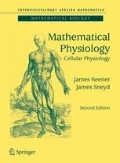The cell membrane provides a boundary separating the internal workings of the cell from its external environment. More importantly, it is selectively permeable, permitting the free passage of some materials and restricting the passage of others, thus regulat ing the passage of materials into and out of the cell. It consists of a double layer (a bilayer) of phospholipid molecules about 7.5 nm (75 angstroms) thick (Fig. 2.1). The term lipid is used to specify a category of water-insoluble, energy rich macromolecules, typical of fats, waxes, and oils. Irregularly dispersed throughout the phospholipid bi-layer are aggregates of globular proteins, which are free to move within the layer, giving the membrane a fluid-like appearance. The membrane also contains water-filled pores with diameters of about 0.8 nm, as well as protein-lined pores, called channels, which allow passage of specific molecules. Both the intracellular and extracellular environ ments consist of, among many other things, a dilute aqueous solution of dissolved salts, primarily NaCl and KCl, which dissociate into Na+, K+, and Cl− ions. The cell membrane acts as a barrier to the free flow of these ions and maintains concentration differences of these ions. In addition, the cell membrane acts as a barrier to the flow of water.
Molecules can be transported across the cell membrane by passive transport or active processes. An active process is one that requires the expenditure of energy, while a passive process results solely from the inherent, random movement of molecules. Osmosis, i.e., the diffusion of water down its concentration gradient, is the most im portant process by which water moves through the cell membrane. Simple diffusion accounts for the passage of small molecules through pores and of lipid-soluble molecules through the lipid bilayer. For example, water, urea (a nitrogenous waste product of metabolism), and hydrated Cl− ions diffuse through membrane pores. Oxy gen and carbon dioxide diffuse through the membrane readily because they are soluble in lipids. Sodium and K+ ions pass through ion-specific channels, driven by diffusion and electrical forces. Some other mechanism must account for the transport of larger sugar molecules such as galactose, glucose, and sucrose, as they are too large to pass through membrane pores.
Access this chapter
Tax calculation will be finalised at checkout
Purchases are for personal use only
Preview
Unable to display preview. Download preview PDF.
Author information
Authors and Affiliations
Editor information
Editors and Affiliations
Rights and permissions
Copyright information
© 2009 Springer-Verlag Berlin Heidelberg
About this chapter
Cite this chapter
Keener, J., Sneyd, J. (2009). Cellular Homeostasis. In: Keener, J., Sneyd, J. (eds) Mathematical Physiology. Interdisciplinary Applied Mathematics, vol 8/1. Springer, New York, NY. https://doi.org/10.1007/978-0-387-75847-3_2
Download citation
DOI: https://doi.org/10.1007/978-0-387-75847-3_2
Publisher Name: Springer, New York, NY
Print ISBN: 978-0-387-75846-6
Online ISBN: 978-0-387-75847-3
eBook Packages: Mathematics and StatisticsMathematics and Statistics (R0)

